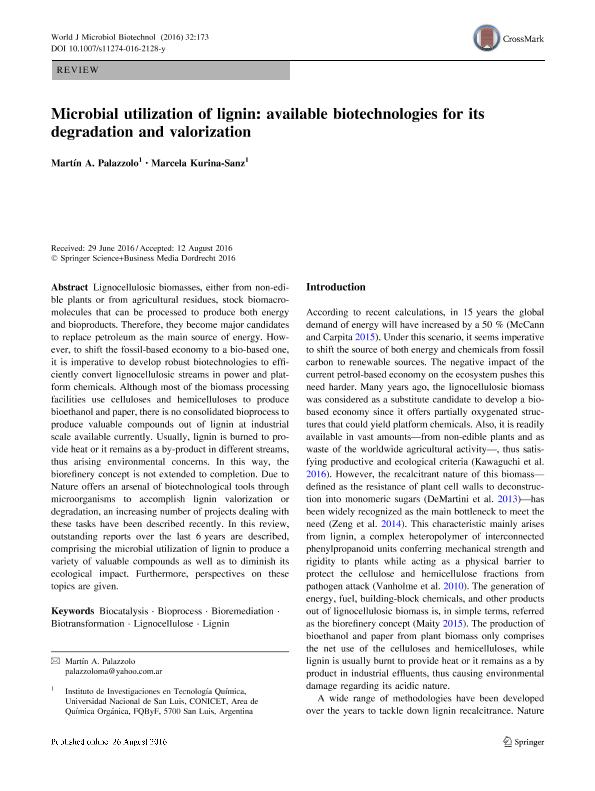Mostrar el registro sencillo del ítem
dc.contributor.author
Palazzolo, Martín Alejandro

dc.contributor.author
Kurina Sanz, Marcela Beatriz

dc.date.available
2023-01-04T11:11:29Z
dc.date.issued
2016-08
dc.identifier.citation
Palazzolo, Martín Alejandro; Kurina Sanz, Marcela Beatriz; Microbial utilization of lignin: available biotechnologies for its degradation and valorization; Springer; World Journal of Microbiology; 32; 10; 8-2016; 1-9
dc.identifier.issn
0959-3993
dc.identifier.uri
http://hdl.handle.net/11336/183242
dc.description.abstract
Lignocellulosic biomasses, either from non-edible plants or from agricultural residues, stock biomacromolecules that can be processed to produce both energy and bioproducts. Therefore, they become major candidates to replace petroleum as the main source of energy. However, to shift the fossil-based economy to a bio-based one, it is imperative to develop robust biotechnologies to efficiently convert lignocellulosic streams in power and platform chemicals. Although most of the biomass processing facilities use celluloses and hemicelluloses to produce bioethanol and paper, there is no consolidated bioprocess to produce valuable compounds out of lignin at industrial scale available currently. Usually, lignin is burned to provide heat or it remains as a by-product in different streams, thus arising environmental concerns. In this way, the biorefinery concept is not extended to completion. Due to Nature offers an arsenal of biotechnological tools through microorganisms to accomplish lignin valorization or degradation, an increasing number of projects dealing with these tasks have been described recently. In this review, outstanding reports over the last 6 years are described, comprising the microbial utilization of lignin to produce a variety of valuable compounds as well as to diminish its ecological impact. Furthermore, perspectives on these topics are given.
dc.format
application/pdf
dc.language.iso
eng
dc.publisher
Springer

dc.rights
info:eu-repo/semantics/openAccess
dc.rights.uri
https://creativecommons.org/licenses/by-nc-sa/2.5/ar/
dc.subject
BIOCATALYSIS
dc.subject
BIOPROCESS
dc.subject
BIOREMEDIATION
dc.subject
BIOTRANSFORMATION
dc.subject
LIGNIN
dc.subject
LIGNOCELLULOSE
dc.subject.classification
Bioprocesamiento Tecnológico, Biocatálisis, Fermentación

dc.subject.classification
Biotecnología Industrial

dc.subject.classification
INGENIERÍAS Y TECNOLOGÍAS

dc.subject.classification
Bioproductos, Biomateriales, Bioplásticos, Biocombustibles, Bioderivados, etc.

dc.subject.classification
Biotecnología Industrial

dc.subject.classification
INGENIERÍAS Y TECNOLOGÍAS

dc.subject.classification
Biotecnología Medioambiental

dc.subject.classification
Biotecnología del Medio Ambiente

dc.subject.classification
INGENIERÍAS Y TECNOLOGÍAS

dc.title
Microbial utilization of lignin: available biotechnologies for its degradation and valorization
dc.type
info:eu-repo/semantics/article
dc.type
info:ar-repo/semantics/artículo
dc.type
info:eu-repo/semantics/publishedVersion
dc.date.updated
2023-01-03T17:49:28Z
dc.journal.volume
32
dc.journal.number
10
dc.journal.pagination
1-9
dc.journal.pais
Alemania

dc.journal.ciudad
Berlin
dc.description.fil
Fil: Palazzolo, Martín Alejandro. Consejo Nacional de Investigaciones Científicas y Técnicas. Centro Científico Tecnológico Conicet - San Luis. Instituto de Investigaciones en Tecnología Química. Universidad Nacional de San Luis. Facultad de Química, Bioquímica y Farmacia. Instituto de Investigaciones en Tecnología Química; Argentina
dc.description.fil
Fil: Kurina Sanz, Marcela Beatriz. Consejo Nacional de Investigaciones Científicas y Técnicas. Centro Científico Tecnológico Conicet - San Luis. Instituto de Investigaciones en Tecnología Química. Universidad Nacional de San Luis. Facultad de Química, Bioquímica y Farmacia. Instituto de Investigaciones en Tecnología Química; Argentina
dc.journal.title
World Journal of Microbiology

dc.relation.alternativeid
info:eu-repo/semantics/altIdentifier/doi/http://dx.doi.org/10.1007/s11274-016-2128-y
Archivos asociados
